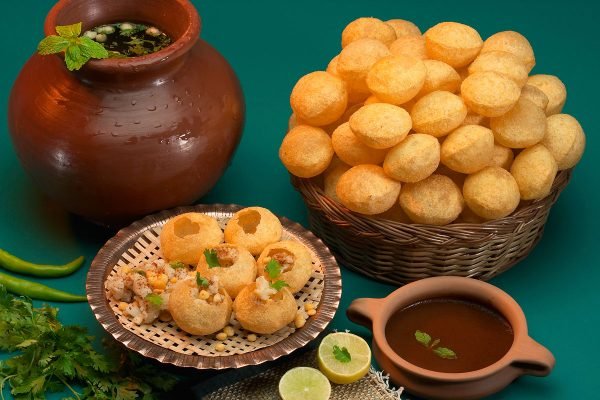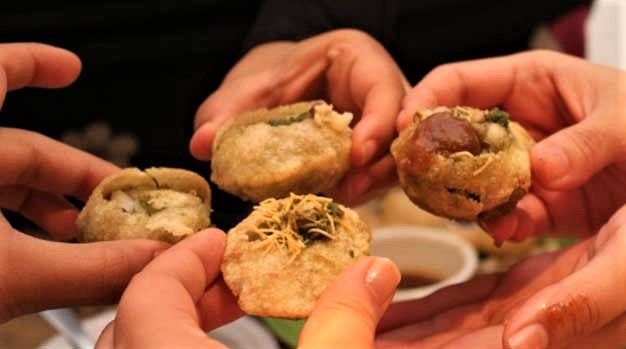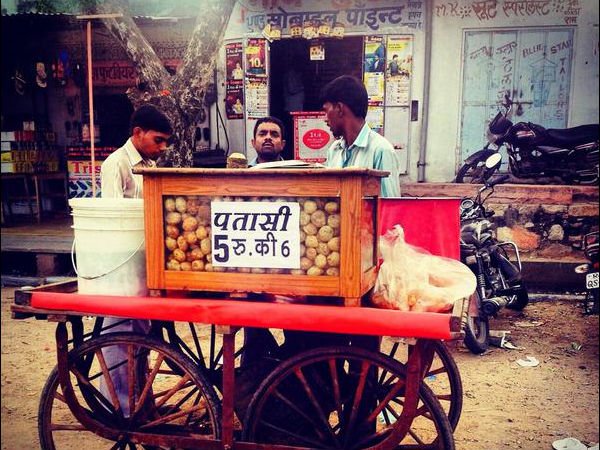Panipuri (About this sound pānīpūrī ) is a common street snack in several regions of the Indian subcontinent.
Panipuri
Panipuri, Golgappa, Phuchka.
Type Snack
Place of origin India
Region or state Bengal , Odisha
Main ingredients Flour, spiced water, onions, potatoes, chickpeas
Cookbook: Panipuri Media: Panipuri
It consists of a round, hollow puri, fried crisp and filled with a mixture of flavored water (commonly known as imli pani), tamarind chutney, chili, chaat masala, potato, onion and chickpeas.[1]
This innocuous street snack is also a great leveller – at a pani puri stall, you will see besuited businessmen step out of sleek cars to join the queue alongside the city’s poorest residents.
😃 Names of street snack all over india depending on the regions :
=>> Panipuri has various names, depending on the region. In Haryana it is called paani ke patashe; in Madhya Pradesh fulki; in Uttar Pradesh golgappa, in West Bengal, Bangladesh, Odisha, and Nepal, puchka; in parts of Gujarat, pakodi; in parts of Bihar ,South Jharkhand, and Chhattisgarh, gup chup.
Puchka differs from panipuri in terms of content and taste. It uses a mixture of boiled gram and mashed potatoes as the filling and is tangy rather than sweetish while the water is sour and spicy.
✌ Panipuri in our History of Invention:
=>> One of the 16 Mahajanapadas (great kingdoms in Sanskrit) of ancient India, the Magadhan empire was situated on the banks of River Ganga in what is now west-central Bihar. Lively accounts of Magadh and its capital, Pataliputra, are available in the travel diaries of the Greek historian Megasthenes and the Chinese Buddhist pilgrims Faxian and Xuanzang.
It is believed that phulkis (the precursor to pani puri) first originated in Magadh at a time when several traditional specialities of the region, like chitba, pitthow, tilba and chewda of Katarni rice, were evolving. The culinary genius who invented them is lost in the pages of history, but if Indians had known who invented pani puri (or whatever you call this yummy snack), they would have thanked that person for generations!
MYTHOLOGICAL CONECTION OF PANIPURI : In the epic Mahabharata, a newly-wedded Draupadi returns home to be given a task by her mother-in-law Kunti. The Pandavas were on exile and Kunti wanted to test if her new daughter-in-law would be able to manage with the scarce resources.
So she gave Draupadi some leftover potato sabzi and just enough wheat dough to make one puri, instructing her to make food that would satisfy the hunger of all five of her sons. It is believed that this was when the new bride invented pani puri. Impressed with her daughter-in-law’s ingenuity, Kunti blessed the dish with immortality.
👀Fuchka/ Panipuri the Heart of India :
=>> While the origins of this delicious snack is yet to be pinpointed with historical accuracy, the one thing that is clear is that pani puri travelled across India and made the country fall head over heels in love with it. Over the years, the combinations underwent many changes as each region developed its own version according to its preferences.
As a result, pani puri today has almost a dozen different names that changes from region to region. In most parts of central and southern India, it is called pani puri but the recipes have subtle variations. While in Maharashtra, hot ragda (white peas curry) is added to the potato mash, in Gujarat, it is boiled moong and in Karnataka, it is chopped onions.
In north India, pani puri is called gol gappe, gup chup, pani ke pataashe or phulkis. The signature element of this recipe is a spicy stuffing made out of a potato-chickpea mash and really tangy water, liberally infused with mint leaves. Interestingly, in Hoshangabad in Madhya Pradesh, pani puri is called tikki, which is usually used to denote crispy potato patties in north India!
In West Bengal, pani puri is called phuchka, probably due to the ‘phuch’ sound it makes when you take a bite. The unique feature of the phuchka lies in the fact that it’s made of wholewheat, unlike the other that are usually made of flour or semolina. The phuchka water is also a little spicier and tangier than that used in the rest of the country.
Here are a few of our favourite pani puri joints from different parts of the country. If you know a place that serves the best panipuri you have ever had, let us know in the comments
Mumbai: Elco Market in Bandra
Delhi: Chote Lal Chaat Bhandar at Chawri Bazaar
Kolkata: Phuchka stall outside Victoria Memorial
Bangalore: Rakesh Kumar’s Pani Puri in Jayanagar
Chennai: Gangotree in Gopalapuram
Hyderabad: Maharaja Chaat in Jubilee Hills.
Lucknow: King of Chaat in Hazaratganj,
Ahmedabad: Shantaben Panipuriwala in Ellisbridge Corner
Nagpur: Gurukrupa Chaat Centre in Pratap Nagar
Patna: Pani puri stall in Maurya Lok complex
Pune: Jaishanker Panipuri wala in Babajan Chowk
Chandigarh: Ram Chaat Bhandaar in sector 34
Guwahati: Ramdev Puchka stall in Kumarpara Panchali.

I love India i love my kolkata and i love phuchka.look my our place phuchka stall👇👇👇

Hi! I am a robot. I just upvoted you! I found similar content that readers might be interested in:
https://www.thebetterindia.com/90031/pani-puri-golgappa-phuchka-history-magadh-mahabharat/